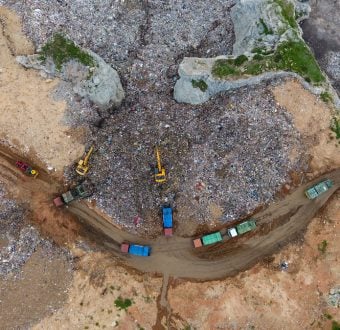
The environmental justice movement that is surging globally is intentionally intersectional, showing how global warming is connected to issues such as race, poverty, migration and public health. One area intimately linked to the climate crisis that gets little attention, however, is militarism. Here are some of the ways these issues—and their solutions—are intertwined.
1. The U.S. military protects Big Oil and other extractive industries.
The U.S. military has often been used to ensure that U.S. companies have access to extractive industry materials, particularly oil, around the world. American forces have also been used to keep oil supplies in the hands of friendly regimes, whether or not they are exported to the U.S. The 1991 Gulf War against Iraq was a blatant example of war for oil; today the U.S. military support for Saudi Arabia is connected to the U.S. fossil fuel industry’s determination to control access to the world’s oil. Hundreds of the U.S. military bases spread around the world are in resource-rich regions and near strategic shipping lanes. We can’t get off the fossil fuel treadmill until we stop our military from acting as the world’s protector of Big Oil.
2. The Pentagon is the single largest institutional consumer of fossil fuels in the world.
Despite making large investments in renewables to make its bases more resilient and combat-zone operations less vulnerable to attack, there is no match for the size of the U.S. military’s “carbon bootprint.” If the Pentagon were a country, its fuel use alone would make it the 47th largest greenhouse gas emitter in the world, greater than entire nations such as Sweden, Norway or Finland. U.S. military emissions come mainly from fueling weapons and equipment, as well as lighting, heating and cooling more than 560,000 buildings around the world.
Surprise! Surprise!
Mainstream media has been concealing reports that link US #militarism to #ClimateChange.
Help save our planet and spread the message that #WarIsNotGreen. https://t.co/irtyLe22yk pic.twitter.com/WQKmA83S2Z
— CODEPINK (@codepink) October 10, 2019
3. The Pentagon monopolizes the funding we need to seriously address the climate crisis.
We are now spending over half of the federal government’s annual discretionary budget on the military when the biggest threat to U.S. national security is not Iran or China, but the climate crisis. We could cut the Pentagon’s current budget in half and still be left with a bigger military budget than China, Russia, Iran, and North Korea combined. The $350 billion savings could then be funneled into the Green New Deal. Just one percent of the 2019 military budget of $716 billion would be enough to fund 128,879 green infrastructure jobs instead, and it would take just 11 percent — or $80 billion — to produce enough wind and solar energy to power every household in the United States.
4. Military operations leave a toxic legacy in their wake.
U.S. military bases despoil the landscape, pollute the soil, and contaminate the drinking water. At the Kadena Base in Okinawa, the U.S. Air Force has polluted local land and water with hazardous chemicals, including arsenic, lead, polychlorinated biphenyls (PCBs), asbestos and dioxin. Here at home, the EPA has identified over 149 current or former military bases as Superfund sites because Pentagon pollution has left local soil and groundwater highly dangerous to human, animal, and plant life. Before Trump declared a “national emergency” to build his wall, his EPA Director Scott Pruitt called contamination of drinking water by PFAS flame retardant chemicals used at military bases a “national emergency.” Even though the scope of the problem is not fully understood, the cost of cleaning up the mess is enormous. According to a 2017 government report, the Pentagon has already spent $11.5 billion on environmental cleanup of closed bases and estimates that at least $3.4 billion more will be needed. Removing PFAS from drinking water at military bases alone is expected to cost $2 billion.
5. Wars ravage fragile ecosystems that are crucial to sustaining human health and climate resiliency.
Direct warfare inherently involves the destruction of the environment, through bombings and boots-on-the-ground invasions that destroy the land and infrastructure. In Yemen, the use of bombs and weapons — many manufactured by U.S. war profiteers such as Raytheon and Lockheed Martin — has created a humanitarian and environmental catastrophe, with more than 2,000 cases of cholera now being reported each day. In Iraq, environmental toxins left behind by the Pentagon’s devastating 2003 invasion include depleted uranium, which has left children living near U.S. bases with an increased risk of congenital heart disease, spinal deformities, cancer, leukemia, cleft lip, and missing or malformed and paralyzed limbs. Between 1962 and 1971, dioxin-laden Agent Orange chemical defoliants were sprayed over the jungles and rice paddies of Vietnam, eventually affecting the health of at least 3 million people, according to the Red Cross.
Stop war, save our mother. DC climate strike pic.twitter.com/4QVW7MZTJI
— Medea Benjamin (@medeabenjamin) September 20, 2019
6. Climate change is a “threat multiplier” that makes already dangerous social and political situations even worse.
We have started to witness the kinds of climate-driven conflicts that top U.S. intelligence and military strategists have written about for decades. In Syria, some research suggests that the worst drought in 500 years led to crop failures that pushed farmers into cities, exacerbating the unemployment and political unrest that contributed to the uprising in 2011. Similar climate crises are thought to have contributed to conflicts in other countries across the Middle East, from Yemen to Libya. As global temperatures continue to rise, there will be more ecological disasters, more mass migrations, and more wars. There will also be more domestic armed clashes—including civil wars—that can spill beyond borders and destabilize entire regions. The areas most at risk are sub-Saharan Africa, the Middle East, and South, Central, and Southeast Asia.
7. The U.S. sabotages international agreements addressing climate change and war.
The U.S. has deliberately and consistently undermined the world’s collective efforts to address the climate crisis by cutting greenhouse gas emissions and speeding the transition to renewable energy. The U.S. refused to join the 1997 Kyoto Protocol and Donald Trump’s withdrawal from the 2015 Paris Climate Accord is but the latest example of a pattern of flagrant disregard for nature, science, and the future. Similarly, the U.S. refuses to join the International Criminal Court that investigates war crimes, violates international law with unilateral invasions and sanctions, and is withdrawing from nuclear agreements with Russia. By choosing a dangerous mix of nationalist doctrine and military superiority over diplomacy, the U.S. sends the message that “might makes right” and makes it harder to find solutions to the climate crisis and military conflicts.
8. Mass migration is fueled by both climate change and conflict, with migrants often facing militarized repression.
A 2018 World Bank Group report estimates that the impacts of climate change in three of the world’s most densely populated developing regions—sub-Saharan Africa, South Asia, and Latin America—could result in the displacement and internal migration of more than 140 million people before 2050. Already, migrants from the Middle East, Africa, and other regions are fleeing from climate-driven changes such as prolonged drought. At the U.S. border, migrants from affected areas in Central America are being locked in cages and stranded in camps. Meanwhile, arms dealers fuelling the conflicts in these regions are profiting handsomely from selling arms and building detention facilities to secure the borders against the refugees.
“There is no appetite to address either the relief for the refugees and migrants or the root causes of migration. There is, in fact, relative silence.” – @vijayprashad https://t.co/LgGh8S2xjE
The war machine creates refugees. Let’s #divestfromwar: https://t.co/7qM8xnZHGw pic.twitter.com/I4rMIf12xM
— CODEPINK (@codepink) November 30, 2017
9. Militarized state violence is leveled against communities resisting corporate-led environmental destruction.
Communities that fight to protect their lands and villages from oil drillers, mining companies, ranchers, agribusiness, etc. are often met with state and paramilitary violence. We see this in the Amazon today, where indigenous people are murdered for trying to stop clear-cutting and incineration of their forests. We see it in Honduras, where activists like Berta Caceres have been gunned down for trying to preserve their rivers. In 2018, there were 164 documented cases of environmentalists murdered around the world. In the U.S., the indigenous communities protesting plans to build the Keystone oil pipeline in South Dakota were met by police who targeted the unarmed demonstrators with tear gas, bean-bag rounds, and water cannons—intentionally deployed in below-freezing temperatures.
10. Climate change and nuclear war are both existential threats to the planet.
Catastrophic climate change and nuclear war are unique in the existential threat they pose to the very survival of human civilization. The creation of nuclear weapons—and their proliferation—was spurred by global militarism, yet nuclear weapons are rarely recognized as a threat to the future of life on this planet. Even a very “limited” nuclear war, involving less than 0.5% of the world’s nuclear weapons, would be enough to cause catastrophic global climate disruption and a worldwide famine, putting up to 2 billion people at risk. The Bulletin of the Atomic Scientists has set its iconic Doomsday Clock to 2 minutes to midnight, showing the grave need for the ratification of the Treaty on the Prohibition of Nuclear Weapons. New artificial intelligence technologies that could put national defense systems on hair-trigger alert make the kinds of brinksmanship that Trump has engaged in with Iran — and could potentially end up in with Russia or China — all the more dangerous. The environmental movement and the anti-nuke movement need to work hand-in-hand to stop these threats to planetary survival.
CODEPINK co-founder @medeabenjamin: “We must urgently mobilize to save our earth from the two existential threats: catastrophic climate destruction and the looming possibility of nuclear annihilation.” https://t.co/oXdZXvzWnJ pic.twitter.com/NbhDdplkYT
— CODEPINK (@codepink) January 9, 2019
To free up billions of Pentagon dollars for investing in critical environmental projects and to eliminate the environmental havoc of war, movements for a livable, peaceful planet need to put “ending war” at the top of the “must-do” list.


